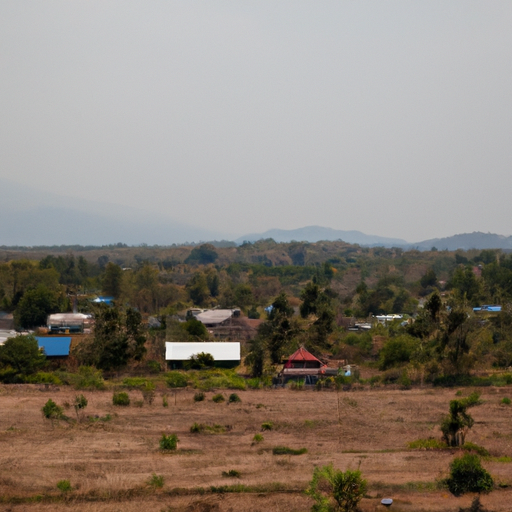-
Table of Contents
- Introduction
- Exploring the Unique Landscapes of Japan
- Exploring the Ancient Landscapes of China
- Exploring the Mystical Landscapes of Tibet
- Exploring the Tropical Landscapes of Thailand
- Exploring the Diverse Landscapes of India
- Exploring the Rugged Landscapes of Mongolia
- Exploring the Spectacular Landscapes of Indonesia
- Q&A
- Conclusion
Introduction
The Asian landscape is one of the most diverse and beautiful in the world. From the snow-capped peaks of the Himalayas to the lush jungles of Southeast Asia, the region is home to a wide variety of landscapes. From the deserts of Central Asia to the tropical islands of the South Pacific, the Asian landscape is full of stunning natural beauty. From the bustling cities of Tokyo and Shanghai to the tranquil villages of rural China, the Asian landscape is full of culture and history. Whether you’re looking for a relaxing beach vacation or an adventurous trek through the mountains, the Asian landscape has something for everyone.
Exploring the Unique Landscapes of Japan
Japan is a country of unique and varied landscapes, from the snow-capped peaks of the Japanese Alps to the lush forests of the northern island of Hokkaido. From the bustling cities of Tokyo and Osaka to the tranquil countryside of the rural prefectures, Japan offers a wealth of natural beauty and cultural experiences.
The Japanese Alps, located in the central region of the country, are a stunning mountain range that is home to some of the highest peaks in Japan. The area is known for its breathtaking views, with snow-capped mountains, deep valleys, and lush forests. The area is also home to a variety of wildlife, including the Japanese macaque, the Japanese serow, and the Japanese black bear.
Hokkaido, the northernmost island of Japan, is a land of rugged beauty. The island is home to vast forests, crystal-clear lakes, and stunning mountain ranges. The area is also known for its abundance of wildlife, including the red-crowned crane, the Steller’s sea eagle, and the Blakiston’s fish owl.
The cities of Tokyo and Osaka are bustling metropolises that offer a unique blend of modern and traditional culture. Tokyo is home to some of the world’s most iconic landmarks, such as the Tokyo Tower and the Imperial Palace. Osaka is known for its vibrant nightlife and its delicious street food.
The rural prefectures of Japan are a great place to explore the country’s traditional culture. These areas are home to small villages, rice paddies, and ancient shrines. Visitors can experience the traditional lifestyle of the Japanese people, as well as the stunning natural beauty of the countryside.
Japan is a country of unique and varied landscapes, from the snow-capped peaks of the Japanese Alps to the lush forests of Hokkaido. From the bustling cities of Tokyo and Osaka to the tranquil countryside of the rural prefectures, Japan offers a wealth of natural beauty and cultural experiences. Whether you are looking for an adventure or a peaceful retreat, Japan has something for everyone.
Exploring the Ancient Landscapes of China
China is a vast and ancient land, with a rich and varied history. Its landscapes have been shaped by centuries of human activity, and the country is home to some of the most spectacular natural wonders in the world. From the majestic peaks of the Himalayas to the lush valleys of the Yangtze River, China’s landscapes offer a unique and captivating glimpse into the past.
The Great Wall of China is one of the most iconic landmarks in the world. Built over 2,000 years ago, the wall stretches for more than 5,500 miles across northern China. It was constructed to protect the Chinese Empire from invading forces, and today it stands as a testament to the ingenuity and strength of the Chinese people.
The Gobi Desert is another of China’s most impressive landscapes. Spanning more than 500,000 square miles, the Gobi is the world’s fourth largest desert. It is home to a variety of unique wildlife, including the endangered wild Bactrian camel. The desert is also home to some of the oldest and most important archaeological sites in the world, including the ruins of the ancient city of Dunhuang.
The Yangtze River is the longest river in Asia, and it is one of the most important waterways in China. The river is home to a variety of wildlife, including the endangered Chinese alligator. The Yangtze is also home to some of the most spectacular scenery in the world, including the Three Gorges Dam, the world’s largest hydroelectric project.
The Himalayas are one of the most awe-inspiring landscapes in the world. Spanning more than 1,500 miles, the Himalayas are home to some of the highest peaks in the world, including Mount Everest. The Himalayas are also home to a variety of unique wildlife, including the snow leopard and the red panda.
China’s landscapes are a testament to its long and varied history. From the Great Wall to the Gobi Desert, the Yangtze River to the Himalayas, these ancient landscapes offer a unique and captivating glimpse into the past. Whether you are looking for adventure or simply want to explore the beauty of nature, China’s landscapes are sure to provide an unforgettable experience.
Exploring the Mystical Landscapes of Tibet
Tibet is a mystical land of breathtaking beauty and spiritual significance. Located in the heart of the Himalayas, it is a place of immense natural beauty, with snow-capped mountains, lush valleys, and crystal-clear lakes. It is also a place of deep spiritual significance, with a rich history of Buddhism and Tibetan culture.
For centuries, Tibet has been a place of pilgrimage for Buddhists and spiritual seekers from around the world. Its unique landscape and culture offer a unique opportunity to explore the mysteries of the spiritual realm. From the ancient monasteries of Lhasa to the sacred lakes of Yamdrok, Tibet is a land of spiritual exploration and discovery.
The landscape of Tibet is breathtakingly beautiful. The snow-capped mountains, lush valleys, and crystal-clear lakes provide a stunning backdrop for exploration. The high altitude of the region also provides a unique opportunity to experience the beauty of the Himalayas.
Tibet is also home to a rich cultural heritage. Tibetan Buddhism is one of the oldest forms of Buddhism, and its influence can be seen in the many monasteries and temples throughout the region. Tibetan culture is also deeply rooted in the traditional arts, such as painting, sculpture, and music.
Tibet is a place of great spiritual significance. It is a place of pilgrimage for Buddhists and spiritual seekers from around the world. Its unique landscape and culture offer a unique opportunity to explore the mysteries of the spiritual realm. From the ancient monasteries of Lhasa to the sacred lakes of Yamdrok, Tibet is a land of spiritual exploration and discovery.
Whether you are looking for a spiritual journey or simply a chance to explore the beauty of the Himalayas, Tibet is a destination that will not disappoint. With its stunning landscapes, rich cultural heritage, and spiritual significance, Tibet is a place of exploration and discovery that will leave you with a lasting impression.
Exploring the Tropical Landscapes of Thailand
Thailand is a tropical paradise, boasting lush landscapes, stunning beaches, and vibrant culture. From the bustling city of Bangkok to the tranquil islands of the south, Thailand offers a wealth of experiences for travelers.
The country is home to a variety of landscapes, from the mountainous north to the tropical south. In the north, visitors can explore the lush jungles of Chiang Mai, trekking through the dense foliage and visiting hill tribes. The region is also home to some of Thailand’s most spectacular waterfalls, such as the Mae Sa Waterfall.
In the south, visitors can explore the stunning beaches of the Andaman Sea. The islands of Koh Samui, Koh Phangan, and Koh Tao are popular destinations for beachgoers, offering crystal-clear waters and white-sand beaches. The nearby Similan Islands are also a popular spot for snorkeling and diving, with their vibrant coral reefs and abundant marine life.
The central region of Thailand is home to the country’s capital, Bangkok. Here, visitors can explore the city’s vibrant culture, sampling delicious street food and visiting the city’s many temples and palaces. The nearby Ayutthaya Historical Park is also a must-see, with its ancient ruins and temples.
No matter where you go in Thailand, you’ll find a wealth of experiences to enjoy. From the lush jungles of the north to the stunning beaches of the south, Thailand’s tropical landscapes offer something for everyone.
Exploring the Diverse Landscapes of India
India is a land of immense diversity, with its landscapes ranging from the snow-capped Himalayas in the north to the tropical beaches of the south. From the lush green valleys of the northeast to the vast deserts of the west, India is a country of varied topography.
The Himalayas, the world’s highest mountain range, form the northern boundary of India. This range is home to some of the world’s highest peaks, including Mount Everest, Kanchenjunga, and Nanda Devi. The Himalayas are also home to some of India’s most beautiful valleys, such as Kashmir, Himachal Pradesh, and Uttarakhand.
The Thar Desert, located in the western part of India, is one of the largest deserts in the world. This desert is characterized by its vast expanse of sand dunes and sparse vegetation. The desert is home to a variety of wildlife, including the endangered Great Indian Bustard.
The Deccan Plateau, located in the south-central part of India, is a vast plateau that covers much of the country. This plateau is home to some of India’s most famous monuments, such as the Taj Mahal and the Ajanta and Ellora Caves. The plateau is also home to some of India’s most beautiful wildlife sanctuaries, such as the Kanha National Park and the Bandhavgarh National Park.
The northeast of India is home to some of the country’s most beautiful landscapes. This region is characterized by its lush green valleys, rolling hills, and dense forests. The region is home to some of India’s most famous national parks, such as Kaziranga National Park and Manas National Park.
India is a land of immense diversity, with its landscapes ranging from the snow-capped Himalayas in the north to the tropical beaches of the south. From the lush green valleys of the northeast to the vast deserts of the west, India is a country of varied topography. With its diverse landscapes, India is a country that is sure to captivate and inspire any traveler.
Exploring the Rugged Landscapes of Mongolia
Mongolia is a land of rugged beauty, with vast steppes, rolling hills, and snow-capped mountains. It is a land of contrasts, with a harsh climate and a rich cultural heritage.
The Mongolian landscape is characterized by its vast steppes, which cover much of the country. These grasslands are home to a variety of wildlife, including the iconic Mongolian gazelle, the endangered snow leopard, and the wild Bactrian camel. The steppes are also dotted with small villages, where nomadic herders live in traditional yurts and tend to their livestock.
The rolling hills of Mongolia are also a sight to behold. These hills are covered in lush vegetation, and are home to a variety of wildlife, including the endangered snow leopard. The hills are also dotted with ancient monasteries, which are a testament to the country’s rich cultural heritage.
Finally, the snow-capped mountains of Mongolia are a sight to behold. These mountains are home to a variety of wildlife, including the endangered snow leopard. The mountains are also dotted with ancient monasteries, which are a testament to the country’s rich cultural heritage.
Mongolia is a land of rugged beauty, with vast steppes, rolling hills, and snow-capped mountains. It is a land of contrasts, with a harsh climate and a rich cultural heritage. Exploring the rugged landscapes of Mongolia is an unforgettable experience, and one that will stay with you for a lifetime.
Exploring the Spectacular Landscapes of Indonesia
Indonesia is a country of unparalleled beauty and diversity. From its lush rainforests to its stunning beaches, the country offers a wealth of spectacular landscapes that are sure to captivate any traveler.
The island of Bali is one of the most popular destinations in Indonesia, and it is easy to see why. With its stunning beaches, lush jungles, and vibrant culture, Bali is a paradise for those seeking a tropical getaway. From the iconic Uluwatu Temple to the stunning Tanah Lot, Bali is home to some of the most breathtaking sights in the world.
The island of Java is another popular destination in Indonesia. Home to the capital city of Jakarta, Java is a bustling metropolis with a vibrant culture and a wealth of attractions. From the ancient temples of Borobudur to the bustling markets of Jakarta, Java is a great place to explore.
The island of Sumatra is home to some of the most stunning landscapes in Indonesia. From the lush jungles of Gunung Leuser National Park to the stunning beaches of Padang, Sumatra is a paradise for nature lovers. The island is also home to some of the world’s most active volcanoes, including Mount Sinabung and Mount Merapi.
The island of Sulawesi is another popular destination in Indonesia. Home to the stunning Tana Toraja region, Sulawesi is a great place to explore the unique culture and traditions of the island. From the traditional Torajan villages to the stunning beaches of Manado, Sulawesi is a great place to experience the beauty of Indonesia.
Indonesia is a country of unparalleled beauty and diversity. From its lush rainforests to its stunning beaches, the country offers a wealth of spectacular landscapes that are sure to captivate any traveler. Whether you are looking for a tropical getaway or an adventure in the wild, Indonesia has something for everyone.
Q&A
1. What is the most common type of landscape in Asia?
The most common type of landscape in Asia is tropical rainforest.
2. What are some of the unique features of Asian landscapes?
Some of the unique features of Asian landscapes include lush vegetation, diverse wildlife, and dramatic mountain ranges.
3. What is the most popular type of garden in Asia?
The most popular type of garden in Asia is a Japanese garden, which typically features a pond, a bridge, and carefully manicured plants and trees.
4. What are some of the most popular plants used in Asian landscapes?
Some of the most popular plants used in Asian landscapes include bonsai trees, bamboo, orchids, and lotus flowers.
5. What is the most common type of architecture found in Asian landscapes?
The most common type of architecture found in Asian landscapes is traditional Chinese architecture, which typically features curved roofs, ornate carvings, and bright colors.
6. What are some of the most popular activities in Asian landscapes?
Some of the most popular activities in Asian landscapes include hiking, bird watching, and exploring ancient temples and monuments.
7. What are some of the most important elements of Asian landscape design?
Some of the most important elements of Asian landscape design include creating a sense of balance and harmony, using natural materials, and incorporating elements of nature into the design.
Conclusion
The Asian landscape is a diverse and vibrant one, with a wide range of cultures, languages, and landscapes. From the lush jungles of Southeast Asia to the snow-capped mountains of the Himalayas, the Asian landscape is a beautiful and unique one. It is a place of great beauty and diversity, and it is a place that should be explored and appreciated.




